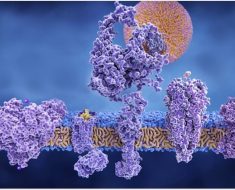Sepsis is a major cause of preventable death among newborn children in tropical countries. Now the antibiotic ceftriaxone, which has been available only as an injectable, can be administered through rectal delivery. This method could annually save the lives of several hundred thousand newborns with sepsis. The research is published in Antimicrobial Agents and Chemotherapy, a journal of the American Society for Microbiology.
Sepsis is an overwhelming immune response to infection that can lead to tissue damage, organ failure, and death.
There is a need for a rectal formulation because in parts of the world where these deaths are common, resources are limited, sterile hospital settings suitable for injection therapy are few and far between—”… often hours or days away,” and prompt treatment is necessary to save lives, according to the report.
“A rectal antibiotic could reduce mortality by shortening lethal delays in treating critically ill newborns,” said corresponding author Tina Kauss, Ph.D., PharmD, Assistant Professor in Pharmaceutical Technology and Biopharmacy, the University of Bordeaux, France.
The research, a collaboration between Hoffman la Roche and University scientists, summarizes and builds upon work performed in the early 1980s at the drug company, Hoffmann la Roche, said Dr. Kauss. Roche had evaluated injectable and rectal formulations of ceftriaxone, but registered only the injectable product. Their human rectal data remained unpublished.
“Rectal delivery of drugs for severely ill patients has been shown to be life-saving for malaria and could achieve the same objective with neonatal sepsis, a treatable infection,” said Dr. Kauss. Rectal delivery enables treatment even during critical illnesses where neonates are undergoing convulsions, or are unconscious, in shock, or unable to feed.
The collaboration with Hoffmann la Roche boosted the likelihood of success and shortened timelines, as Roche had invested extensively in the chemistry and pharmaceutical development of rectal formulations of ceftriaxone.
“Their data showed that ceftriaxone always needed an absorption enhancer in the formulation to increase rectal bioavailability, and they tested more than 30 absorption enhancers for bioavailability, alone, or in combination with other enhancers in different formulations,” said Dr. Kauss.
Without absorption enhancement, bioavailability—the amount of an agent that reaches its target—hovered in the mid-single digits. With certain absorption enhancers in the formulation, bioavailability reached 50 percent in rabbits, justifying further work in primates and humans, according to the report. In baboons, it reached 69 percent. Additionally, bioavailability via the rectum in week-old infants is double that of adults, therefore requiring fewer doses in infants.
Following their review of the Hoffman data, the investigators developed new formulations. Only those few that proved stable under tropical conditions were developed further, said Dr. Kauss. “Since Roche provided the full information on a fatty-suppository formulation which they had used for studies of bioavailability in humans, we replicated this suppository and assessed its bioavailability in rabbits,” she said. “The new rabbit data therefore provides a reference or benchmark against which one can measure bioavailability of new rectal formulations, in order to predict human bioavailability.”
Ceftriaxone has multiple advantages over other antibiotics. Sepsis has multiple causal pathogens, but ceftriaxone is broad spectrum. It has a good safety record in newborns, good central nervous system penetration, and “a single daily dose is possible because [ceftriaxone] has much slower elimination than other third generation cephalosporins, penicillins, or carbapenems,” according to the report.
Source: Read Full Article





